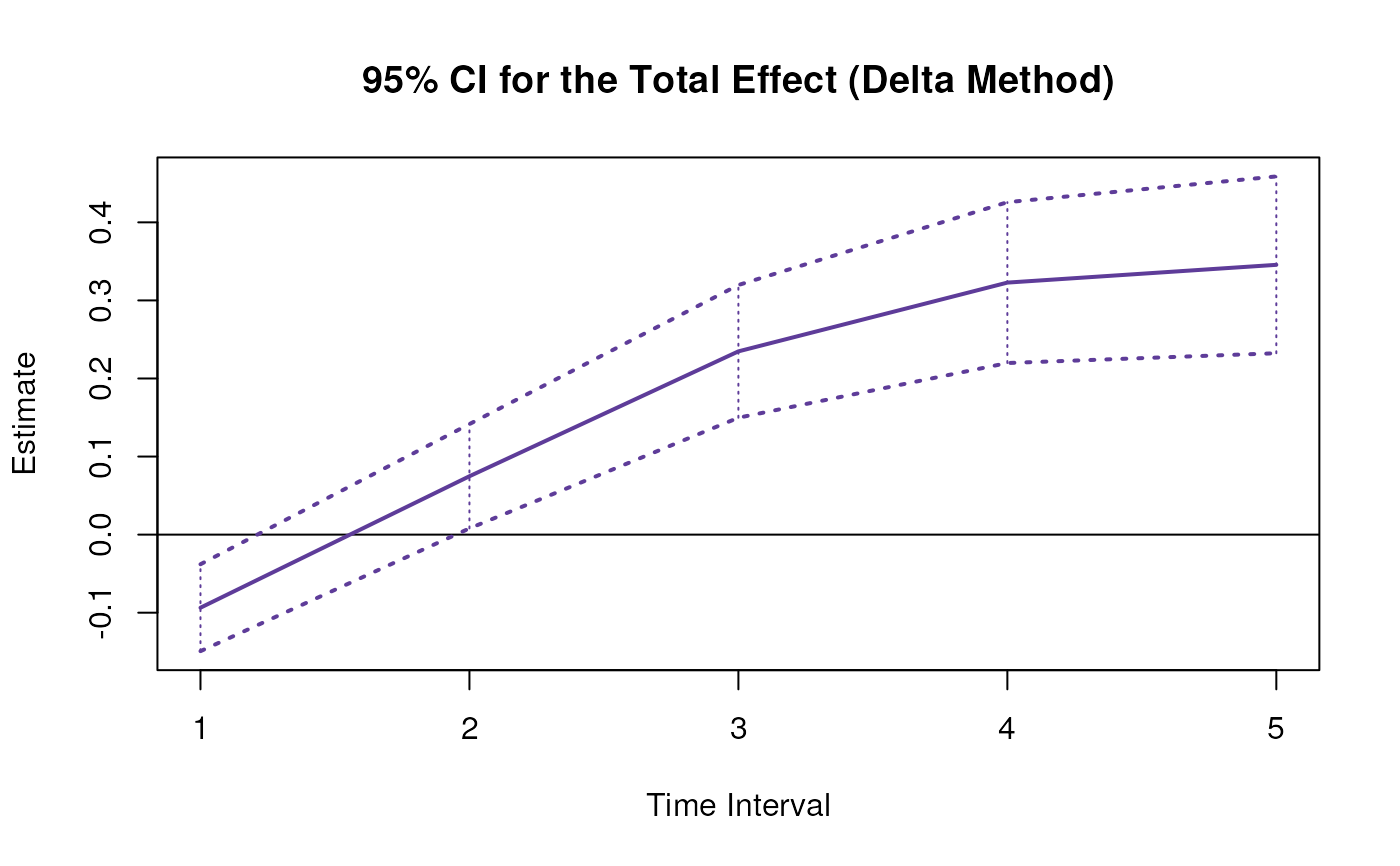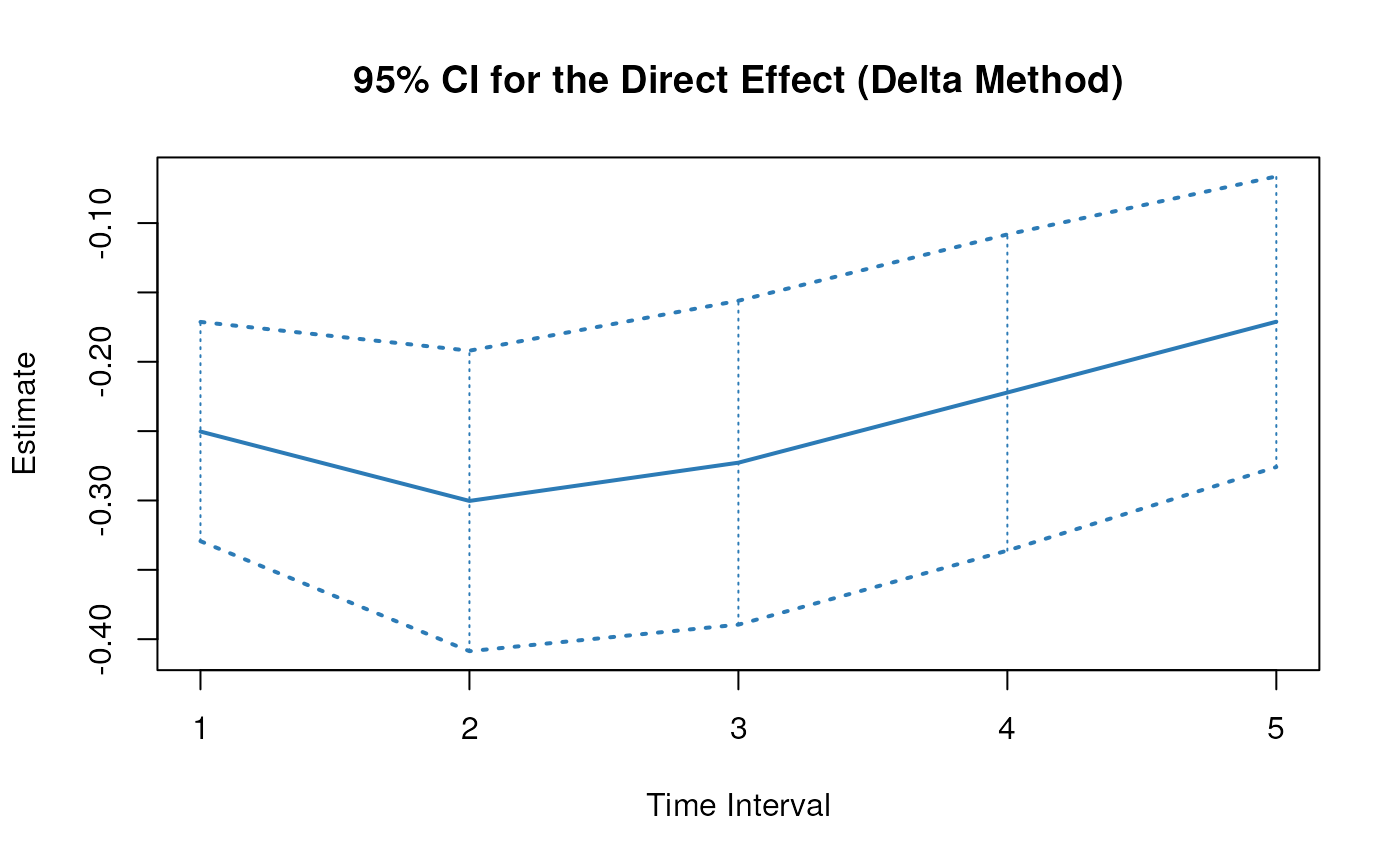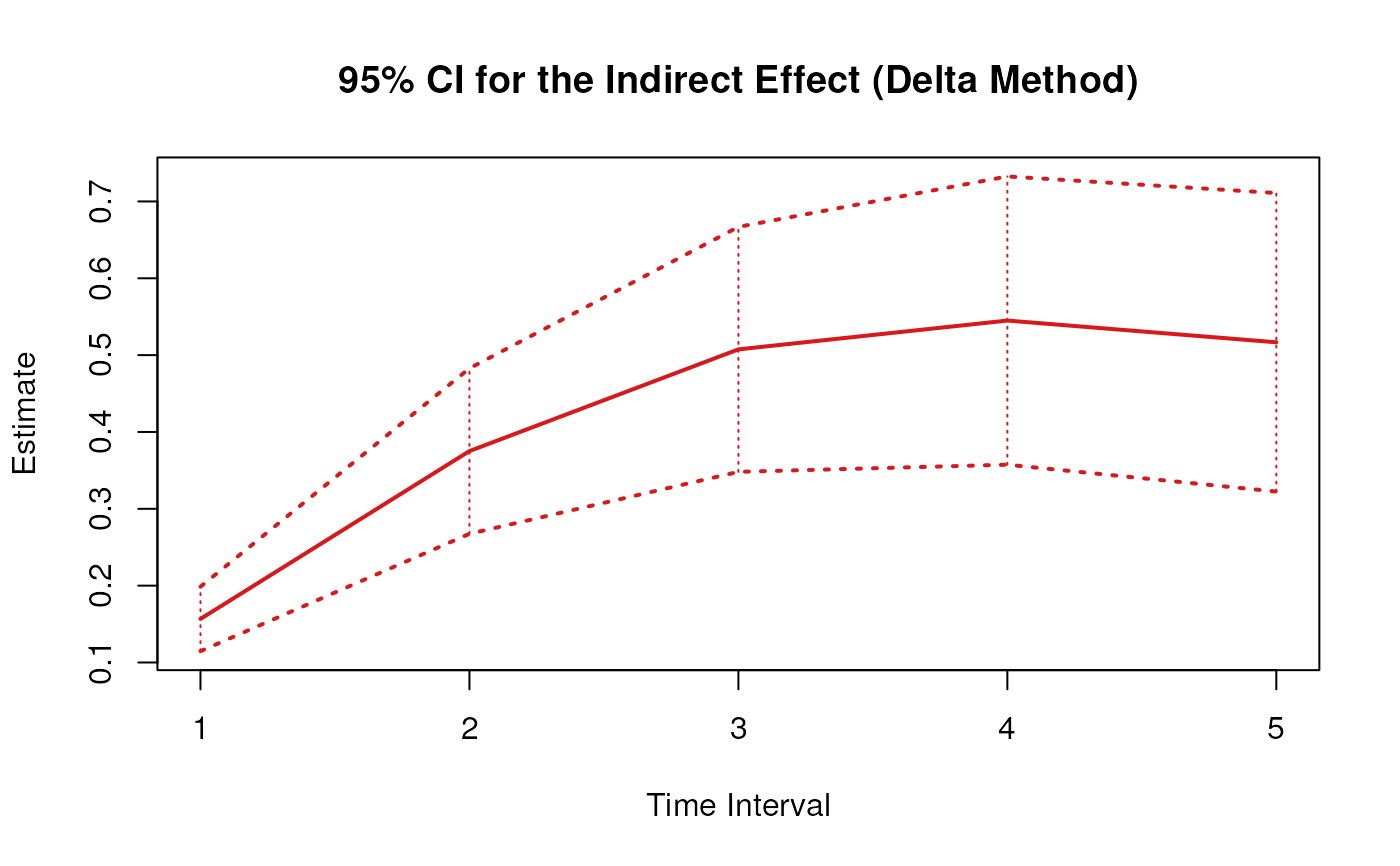Delta Method Sampling Variance-Covariance Matrix for the Standardized Total, Direct, and Indirect Effects of X on Y Through M Over a Specific Time Interval or a Range of Time Intervals
Source:R/cTMed-delta-med-std.R
DeltaMedStd.RdThis function computes the delta method sampling variance-covariance matrix for the standardized total, direct, and indirect effects of the independent variable \(X\) on the dependent variable \(Y\) through mediator variables \(\mathbf{m}\) over a specific time interval \(\Delta t\) or a range of time intervals using the first-order stochastic differential equation model's drift matrix \(\boldsymbol{\Phi}\) and process noise covariance matrix \(\boldsymbol{\Sigma}\).
Arguments
- phi
Numeric matrix. The drift matrix (\(\boldsymbol{\Phi}\)).
phishould have row and column names pertaining to the variables in the system.- sigma
Numeric matrix. The process noise covariance matrix (\(\boldsymbol{\Sigma}\)).
- vcov_theta
Numeric matrix. The sampling variance-covariance matrix of \(\mathrm{vec} \left( \boldsymbol{\Phi} \right)\) and \(\mathrm{vech} \left( \boldsymbol{\Sigma} \right)\)
- delta_t
Numeric. Time interval (\(\Delta t\)).
- from
Character string. Name of the independent variable \(X\) in
phi.- to
Character string. Name of the dependent variable \(Y\) in
phi.- med
Character vector. Name/s of the mediator variable/s in
phi.- ncores
Positive integer. Number of cores to use. If
ncores = NULL, use a single core. Consider using multiple cores when number of replicationsRis a large value.- tol
Numeric. Smallest possible time interval to allow.
Value
Returns an object
of class ctmeddelta which is a list with the following elements:
- call
Function call.
- args
Function arguments.
- fun
Function used ("DeltaMedStd").
- output
A list the length of which is equal to the length of
delta_t.
Each element in the output list has the following elements:
- delta_t
Time interval.
- jacobian
Jacobian matrix.
- est
Estimated standardized total, direct, and indirect effects.
- vcov
Sampling variance-covariance matrix of the estimated standardized total, direct, and indirect effects.
Details
See TotalStd(),
DirectStd(), and
IndirectStd() for more details.
Delta Method
Let \(\boldsymbol{\theta}\) be a vector that combines \(\mathrm{vec} \left( \boldsymbol{\Phi} \right)\), that is, the elements of the \(\boldsymbol{\Phi}\) matrix in vector form sorted column-wise and \(\mathrm{vech} \left( \boldsymbol{\Sigma} \right)\), that is, the unique elements of the \(\boldsymbol{\Sigma}\) matrix in vector form sorted column-wise. Let \(\hat{\boldsymbol{\theta}}\) be a vector that combines \(\mathrm{vec} \left( \hat{\boldsymbol{\Phi}} \right)\) and \(\mathrm{vech} \left( \hat{\boldsymbol{\Sigma}} \right)\). By the multivariate central limit theory, the function \(\mathbf{g}\) using \(\hat{\boldsymbol{\theta}}\) as input can be expressed as:
$$ \sqrt{n} \left( \mathbf{g} \left( \hat{\boldsymbol{\theta}} \right) - \mathbf{g} \left( \boldsymbol{\theta} \right) \right) \xrightarrow[]{ \mathrm{D} } \mathcal{N} \left( 0, \mathbf{J} \boldsymbol{\Gamma} \mathbf{J}^{\prime} \right) $$
where \(\mathbf{J}\) is the matrix of first-order derivatives of the function \(\mathbf{g}\) with respect to the elements of \(\boldsymbol{\theta}\) and \(\boldsymbol{\Gamma}\) is the asymptotic variance-covariance matrix of \(\hat{\boldsymbol{\theta}}\).
From the former, we can derive the distribution of \(\mathbf{g} \left( \hat{\boldsymbol{\theta}} \right)\) as follows:
$$ \mathbf{g} \left( \hat{\boldsymbol{\theta}} \right) \approx \mathcal{N} \left( \mathbf{g} \left( \boldsymbol{\theta} \right) , n^{-1} \mathbf{J} \boldsymbol{\Gamma} \mathbf{J}^{\prime} \right) $$
The uncertainty associated with the estimator \(\mathbf{g} \left( \hat{\boldsymbol{\theta}} \right)\) is, therefore, given by \(n^{-1} \mathbf{J} \boldsymbol{\Gamma} \mathbf{J}^{\prime}\) . When \(\boldsymbol{\Gamma}\) is unknown, by substitution, we can use the estimated sampling variance-covariance matrix of \(\hat{\boldsymbol{\theta}}\), that is, \(\hat{\mathbb{V}} \left( \hat{\boldsymbol{\theta}} \right)\) for \(n^{-1} \boldsymbol{\Gamma}\). Therefore, the sampling variance-covariance matrix of \(\mathbf{g} \left( \hat{\boldsymbol{\theta}} \right)\) is given by
$$ \mathbf{g} \left( \hat{\boldsymbol{\theta}} \right) \approx \mathcal{N} \left( \mathbf{g} \left( \boldsymbol{\theta} \right) , \mathbf{J} \hat{\mathbb{V}} \left( \hat{\boldsymbol{\theta}} \right) \mathbf{J}^{\prime} \right) . $$
References
Bollen, K. A. (1987). Total, direct, and indirect effects in structural equation models. Sociological Methodology, 17, 37. doi:10.2307/271028
Deboeck, P. R., & Preacher, K. J. (2015). No need to be discrete: A method for continuous time mediation analysis. Structural Equation Modeling: A Multidisciplinary Journal, 23 (1), 61–75. doi:10.1080/10705511.2014.973960
Pesigan, I. J. A., Russell, M. A., & Chow, S.-M. (2025). Inferences and effect sizes for direct, indirect, and total effects in continuous-time mediation models. Psychological Methods. doi:10.1037/met0000779
Ryan, O., & Hamaker, E. L. (2021). Time to intervene: A continuous-time approach to network analysis and centrality. Psychometrika, 87 (1), 214–252. doi:10.1007/s11336-021-09767-0
See also
Other Continuous-Time Mediation Functions:
BootBeta(),
BootBetaStd(),
BootIndirectCentral(),
BootMed(),
BootMedStd(),
BootTotalCentral(),
DeltaBeta(),
DeltaBetaStd(),
DeltaIndirectCentral(),
DeltaMed(),
DeltaTotalCentral(),
Direct(),
DirectStd(),
Indirect(),
IndirectCentral(),
IndirectStd(),
MCBeta(),
MCBetaStd(),
MCIndirectCentral(),
MCMed(),
MCMedStd(),
MCPhi(),
MCPhiSigma(),
MCTotalCentral(),
Med(),
MedStd(),
PosteriorBeta(),
PosteriorIndirectCentral(),
PosteriorMed(),
PosteriorTotalCentral(),
Total(),
TotalCentral(),
TotalStd(),
Trajectory()
Examples
phi <- matrix(
data = c(
-0.357, 0.771, -0.450,
0.0, -0.511, 0.729,
0, 0, -0.693
),
nrow = 3
)
colnames(phi) <- rownames(phi) <- c("x", "m", "y")
sigma <- matrix(
data = c(
0.24455556, 0.02201587, -0.05004762,
0.02201587, 0.07067800, 0.01539456,
-0.05004762, 0.01539456, 0.07553061
),
nrow = 3
)
vcov_theta <- matrix(
data = c(
0.00843, 0.00040, -0.00151, -0.00600, -0.00033,
0.00110, 0.00324, 0.00020, -0.00061, -0.00115,
0.00011, 0.00015, 0.00001, -0.00002, -0.00001,
0.00040, 0.00374, 0.00016, -0.00022, -0.00273,
-0.00016, 0.00009, 0.00150, 0.00012, -0.00010,
-0.00026, 0.00002, 0.00012, 0.00004, -0.00001,
-0.00151, 0.00016, 0.00389, 0.00103, -0.00007,
-0.00283, -0.00050, 0.00000, 0.00156, 0.00021,
-0.00005, -0.00031, 0.00001, 0.00007, 0.00006,
-0.00600, -0.00022, 0.00103, 0.00644, 0.00031,
-0.00119, -0.00374, -0.00021, 0.00070, 0.00064,
-0.00015, -0.00005, 0.00000, 0.00003, -0.00001,
-0.00033, -0.00273, -0.00007, 0.00031, 0.00287,
0.00013, -0.00014, -0.00170, -0.00012, 0.00006,
0.00014, -0.00001, -0.00015, 0.00000, 0.00001,
0.00110, -0.00016, -0.00283, -0.00119, 0.00013,
0.00297, 0.00063, -0.00004, -0.00177, -0.00013,
0.00005, 0.00017, -0.00002, -0.00008, 0.00001,
0.00324, 0.00009, -0.00050, -0.00374, -0.00014,
0.00063, 0.00495, 0.00024, -0.00093, -0.00020,
0.00006, -0.00010, 0.00000, -0.00001, 0.00004,
0.00020, 0.00150, 0.00000, -0.00021, -0.00170,
-0.00004, 0.00024, 0.00214, 0.00012, -0.00002,
-0.00004, 0.00000, 0.00006, -0.00005, -0.00001,
-0.00061, 0.00012, 0.00156, 0.00070, -0.00012,
-0.00177, -0.00093, 0.00012, 0.00223, 0.00004,
-0.00002, -0.00003, 0.00001, 0.00003, -0.00013,
-0.00115, -0.00010, 0.00021, 0.00064, 0.00006,
-0.00013, -0.00020, -0.00002, 0.00004, 0.00057,
0.00001, -0.00009, 0.00000, 0.00000, 0.00001,
0.00011, -0.00026, -0.00005, -0.00015, 0.00014,
0.00005, 0.00006, -0.00004, -0.00002, 0.00001,
0.00012, 0.00001, 0.00000, -0.00002, 0.00000,
0.00015, 0.00002, -0.00031, -0.00005, -0.00001,
0.00017, -0.00010, 0.00000, -0.00003, -0.00009,
0.00001, 0.00014, 0.00000, 0.00000, -0.00005,
0.00001, 0.00012, 0.00001, 0.00000, -0.00015,
-0.00002, 0.00000, 0.00006, 0.00001, 0.00000,
0.00000, 0.00000, 0.00010, 0.00001, 0.00000,
-0.00002, 0.00004, 0.00007, 0.00003, 0.00000,
-0.00008, -0.00001, -0.00005, 0.00003, 0.00000,
-0.00002, 0.00000, 0.00001, 0.00005, 0.00001,
-0.00001, -0.00001, 0.00006, -0.00001, 0.00001,
0.00001, 0.00004, -0.00001, -0.00013, 0.00001,
0.00000, -0.00005, 0.00000, 0.00001, 0.00012
),
nrow = 15
)
# Specific time interval ----------------------------------------------------
DeltaMedStd(
phi = phi,
sigma = sigma,
vcov_theta = vcov_theta,
delta_t = 1,
from = "x",
to = "y",
med = "m"
)
#> Call:
#> DeltaMedStd(phi = phi, sigma = sigma, vcov_theta = vcov_theta,
#> delta_t = 1, from = "x", to = "y", med = "m")
#>
#> Total, Direct, and Indirect Effects
#>
#> effect interval est se z p 2.5% 97.5%
#> 1 total 1 -0.1069 0.0345 -3.0977 0.002 -0.1745 -0.0393
#> 2 direct 1 -0.2858 0.0467 -6.1252 0.000 -0.3772 -0.1943
#> 3 indirect 1 0.1789 0.0200 8.9504 0.000 0.1397 0.2181
# Range of time intervals ---------------------------------------------------
delta <- DeltaMedStd(
phi = phi,
sigma = sigma,
vcov_theta = vcov_theta,
delta_t = 1:5,
from = "x",
to = "y",
med = "m"
)
plot(delta)
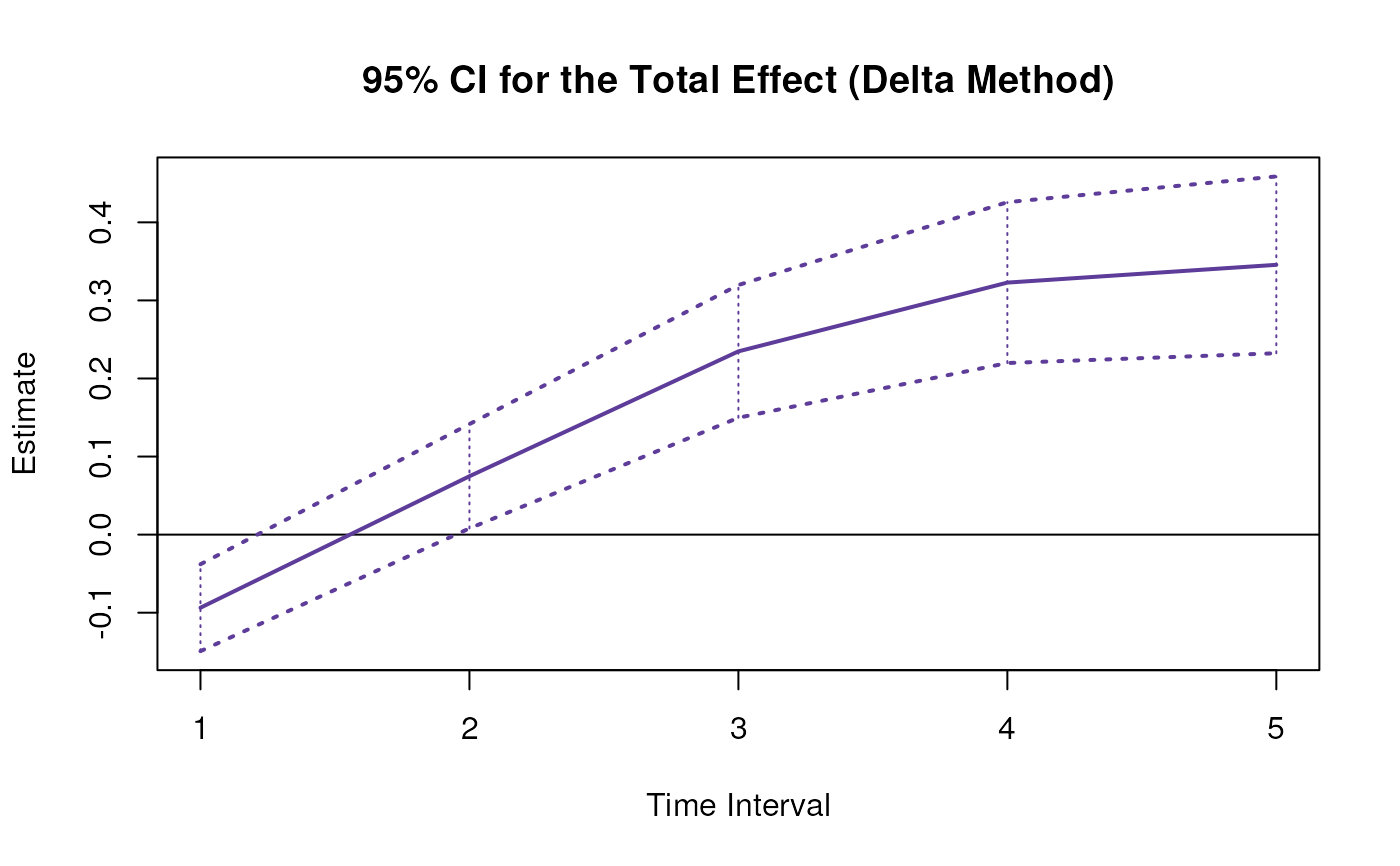
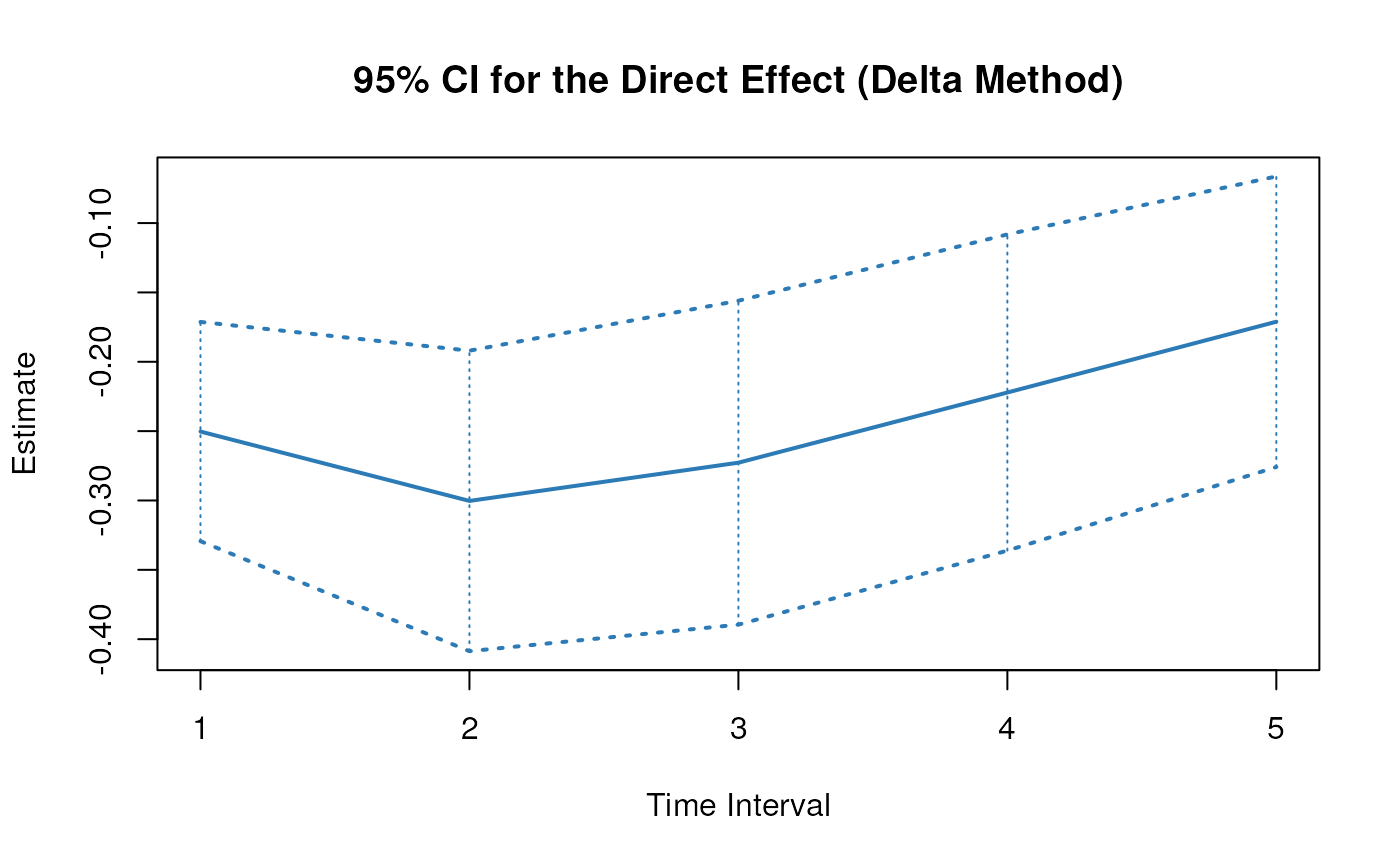
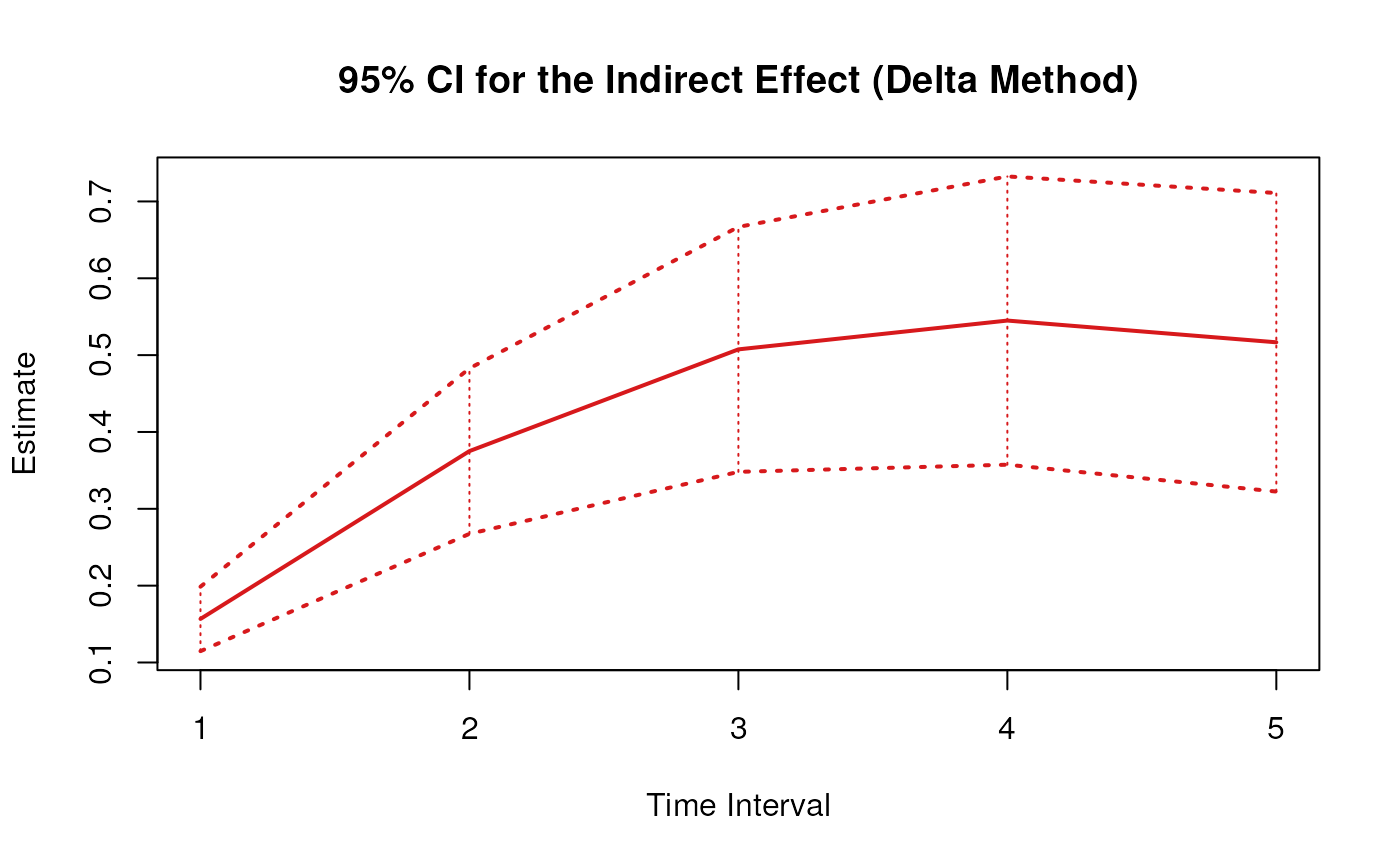 # Methods -------------------------------------------------------------------
# DeltaMedStd has a number of methods including
# print, summary, confint, and plot
print(delta)
#> Call:
#> DeltaMedStd(phi = phi, sigma = sigma, vcov_theta = vcov_theta,
#> delta_t = 1:5, from = "x", to = "y", med = "m")
#>
#> Total, Direct, and Indirect Effects
#>
#> effect interval est se z p 2.5% 97.5%
#> 1 total 1 -0.1069 0.0345 -3.0977 0.0020 -0.1745 -0.0393
#> 2 direct 1 -0.2858 0.0467 -6.1252 0.0000 -0.3772 -0.1943
#> 3 indirect 1 0.1789 0.0200 8.9504 0.0000 0.1397 0.2181
#> 4 total 2 0.0854 0.0351 2.4352 0.0149 0.0167 0.1541
#> 5 direct 2 -0.3429 0.0637 -5.3803 0.0000 -0.4678 -0.2180
#> 6 indirect 2 0.4283 0.0510 8.3988 0.0000 0.3283 0.5282
#> 7 total 3 0.2680 0.0324 8.2632 0.0000 0.2044 0.3316
#> 8 direct 3 -0.3114 0.0687 -4.5336 0.0000 -0.4460 -0.1768
#> 9 indirect 3 0.5794 0.0759 7.6315 0.0000 0.4306 0.7282
#> 10 total 4 0.3686 0.0346 10.6428 0.0000 0.3007 0.4364
#> 11 direct 4 -0.2537 0.0671 -3.7801 0.0002 -0.3852 -0.1221
#> 12 indirect 4 0.6222 0.0901 6.9059 0.0000 0.4456 0.7988
#> 13 total 5 0.3946 0.0392 10.0752 0.0000 0.3178 0.4713
#> 14 direct 5 -0.1954 0.0617 -3.1655 0.0015 -0.3163 -0.0744
#> 15 indirect 5 0.5899 0.0941 6.2696 0.0000 0.4055 0.7744
summary(delta)
#> Call:
#> DeltaMedStd(phi = phi, sigma = sigma, vcov_theta = vcov_theta,
#> delta_t = 1:5, from = "x", to = "y", med = "m")
#>
#> Total, Direct, and Indirect Effects
#>
#> effect interval est se z p 2.5% 97.5%
#> 1 total 1 -0.1069 0.0345 -3.0977 0.0020 -0.1745 -0.0393
#> 2 direct 1 -0.2858 0.0467 -6.1252 0.0000 -0.3772 -0.1943
#> 3 indirect 1 0.1789 0.0200 8.9504 0.0000 0.1397 0.2181
#> 4 total 2 0.0854 0.0351 2.4352 0.0149 0.0167 0.1541
#> 5 direct 2 -0.3429 0.0637 -5.3803 0.0000 -0.4678 -0.2180
#> 6 indirect 2 0.4283 0.0510 8.3988 0.0000 0.3283 0.5282
#> 7 total 3 0.2680 0.0324 8.2632 0.0000 0.2044 0.3316
#> 8 direct 3 -0.3114 0.0687 -4.5336 0.0000 -0.4460 -0.1768
#> 9 indirect 3 0.5794 0.0759 7.6315 0.0000 0.4306 0.7282
#> 10 total 4 0.3686 0.0346 10.6428 0.0000 0.3007 0.4364
#> 11 direct 4 -0.2537 0.0671 -3.7801 0.0002 -0.3852 -0.1221
#> 12 indirect 4 0.6222 0.0901 6.9059 0.0000 0.4456 0.7988
#> 13 total 5 0.3946 0.0392 10.0752 0.0000 0.3178 0.4713
#> 14 direct 5 -0.1954 0.0617 -3.1655 0.0015 -0.3163 -0.0744
#> 15 indirect 5 0.5899 0.0941 6.2696 0.0000 0.4055 0.7744
confint(delta, level = 0.95)
#> effect interval 2.5 % 97.5 %
#> 1 total 1 -0.1745281 -0.03925936
#> 2 direct 1 -0.3772269 -0.19433670
#> 3 indirect 1 0.1397151 0.21806096
#> 4 total 2 0.0166627 0.15408968
#> 5 direct 2 -0.4678058 -0.21798253
#> 6 indirect 2 0.3283280 0.52821273
#> 7 total 3 0.2044337 0.33156916
#> 8 direct 3 -0.4460439 -0.17678487
#> 9 indirect 3 0.4306074 0.72822429
#> 10 total 4 0.3006902 0.43643964
#> 11 direct 4 -0.3851778 -0.12213761
#> 12 indirect 4 0.4456289 0.79881634
#> 13 total 5 0.3178028 0.47131270
#> 14 direct 5 -0.3163438 -0.07440538
#> 15 indirect 5 0.4055114 0.77435334
plot(delta)
# Methods -------------------------------------------------------------------
# DeltaMedStd has a number of methods including
# print, summary, confint, and plot
print(delta)
#> Call:
#> DeltaMedStd(phi = phi, sigma = sigma, vcov_theta = vcov_theta,
#> delta_t = 1:5, from = "x", to = "y", med = "m")
#>
#> Total, Direct, and Indirect Effects
#>
#> effect interval est se z p 2.5% 97.5%
#> 1 total 1 -0.1069 0.0345 -3.0977 0.0020 -0.1745 -0.0393
#> 2 direct 1 -0.2858 0.0467 -6.1252 0.0000 -0.3772 -0.1943
#> 3 indirect 1 0.1789 0.0200 8.9504 0.0000 0.1397 0.2181
#> 4 total 2 0.0854 0.0351 2.4352 0.0149 0.0167 0.1541
#> 5 direct 2 -0.3429 0.0637 -5.3803 0.0000 -0.4678 -0.2180
#> 6 indirect 2 0.4283 0.0510 8.3988 0.0000 0.3283 0.5282
#> 7 total 3 0.2680 0.0324 8.2632 0.0000 0.2044 0.3316
#> 8 direct 3 -0.3114 0.0687 -4.5336 0.0000 -0.4460 -0.1768
#> 9 indirect 3 0.5794 0.0759 7.6315 0.0000 0.4306 0.7282
#> 10 total 4 0.3686 0.0346 10.6428 0.0000 0.3007 0.4364
#> 11 direct 4 -0.2537 0.0671 -3.7801 0.0002 -0.3852 -0.1221
#> 12 indirect 4 0.6222 0.0901 6.9059 0.0000 0.4456 0.7988
#> 13 total 5 0.3946 0.0392 10.0752 0.0000 0.3178 0.4713
#> 14 direct 5 -0.1954 0.0617 -3.1655 0.0015 -0.3163 -0.0744
#> 15 indirect 5 0.5899 0.0941 6.2696 0.0000 0.4055 0.7744
summary(delta)
#> Call:
#> DeltaMedStd(phi = phi, sigma = sigma, vcov_theta = vcov_theta,
#> delta_t = 1:5, from = "x", to = "y", med = "m")
#>
#> Total, Direct, and Indirect Effects
#>
#> effect interval est se z p 2.5% 97.5%
#> 1 total 1 -0.1069 0.0345 -3.0977 0.0020 -0.1745 -0.0393
#> 2 direct 1 -0.2858 0.0467 -6.1252 0.0000 -0.3772 -0.1943
#> 3 indirect 1 0.1789 0.0200 8.9504 0.0000 0.1397 0.2181
#> 4 total 2 0.0854 0.0351 2.4352 0.0149 0.0167 0.1541
#> 5 direct 2 -0.3429 0.0637 -5.3803 0.0000 -0.4678 -0.2180
#> 6 indirect 2 0.4283 0.0510 8.3988 0.0000 0.3283 0.5282
#> 7 total 3 0.2680 0.0324 8.2632 0.0000 0.2044 0.3316
#> 8 direct 3 -0.3114 0.0687 -4.5336 0.0000 -0.4460 -0.1768
#> 9 indirect 3 0.5794 0.0759 7.6315 0.0000 0.4306 0.7282
#> 10 total 4 0.3686 0.0346 10.6428 0.0000 0.3007 0.4364
#> 11 direct 4 -0.2537 0.0671 -3.7801 0.0002 -0.3852 -0.1221
#> 12 indirect 4 0.6222 0.0901 6.9059 0.0000 0.4456 0.7988
#> 13 total 5 0.3946 0.0392 10.0752 0.0000 0.3178 0.4713
#> 14 direct 5 -0.1954 0.0617 -3.1655 0.0015 -0.3163 -0.0744
#> 15 indirect 5 0.5899 0.0941 6.2696 0.0000 0.4055 0.7744
confint(delta, level = 0.95)
#> effect interval 2.5 % 97.5 %
#> 1 total 1 -0.1745281 -0.03925936
#> 2 direct 1 -0.3772269 -0.19433670
#> 3 indirect 1 0.1397151 0.21806096
#> 4 total 2 0.0166627 0.15408968
#> 5 direct 2 -0.4678058 -0.21798253
#> 6 indirect 2 0.3283280 0.52821273
#> 7 total 3 0.2044337 0.33156916
#> 8 direct 3 -0.4460439 -0.17678487
#> 9 indirect 3 0.4306074 0.72822429
#> 10 total 4 0.3006902 0.43643964
#> 11 direct 4 -0.3851778 -0.12213761
#> 12 indirect 4 0.4456289 0.79881634
#> 13 total 5 0.3178028 0.47131270
#> 14 direct 5 -0.3163438 -0.07440538
#> 15 indirect 5 0.4055114 0.77435334
plot(delta)
